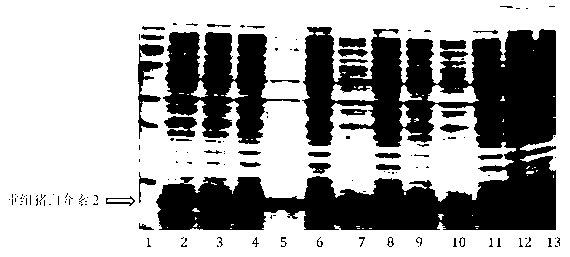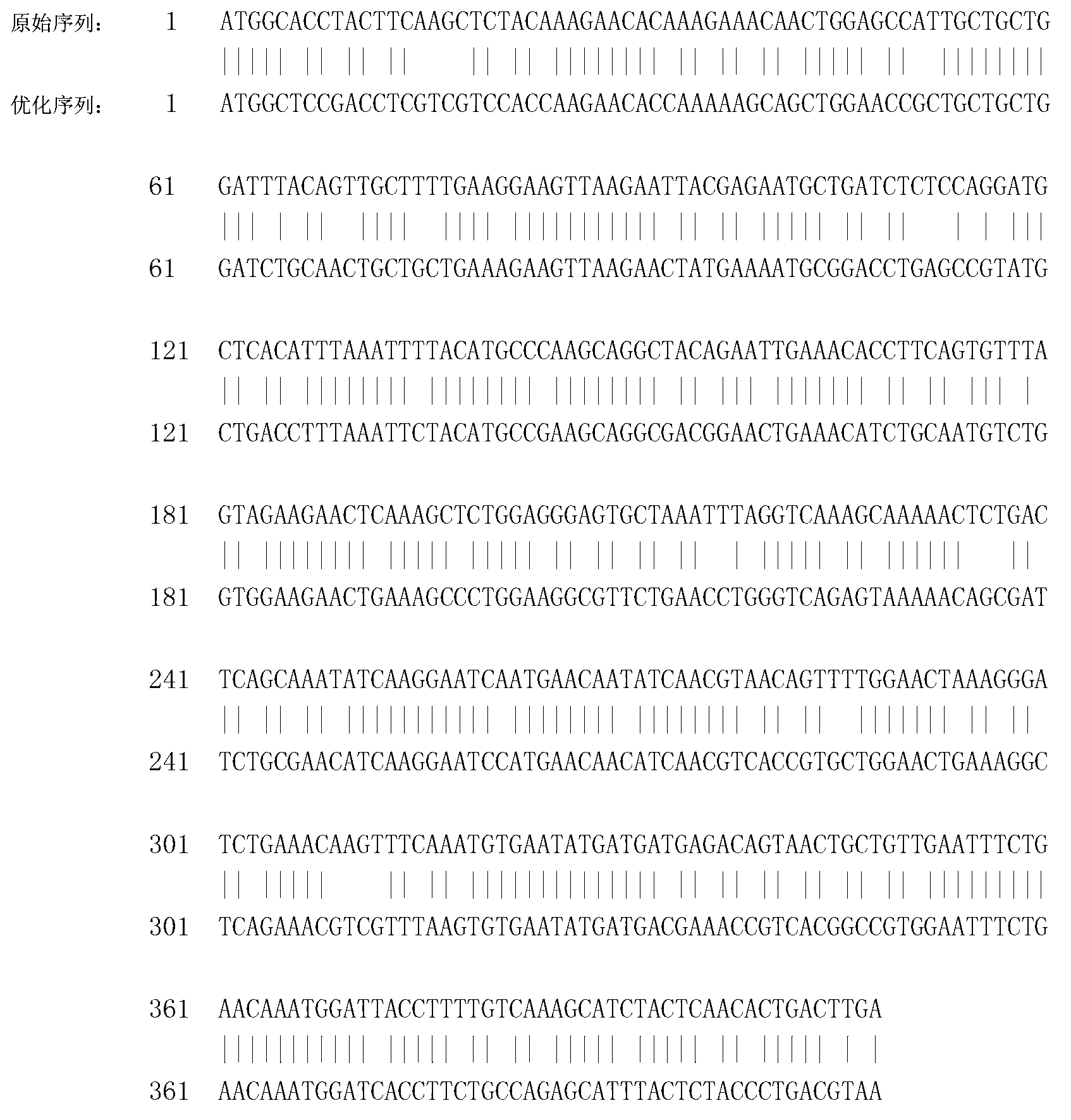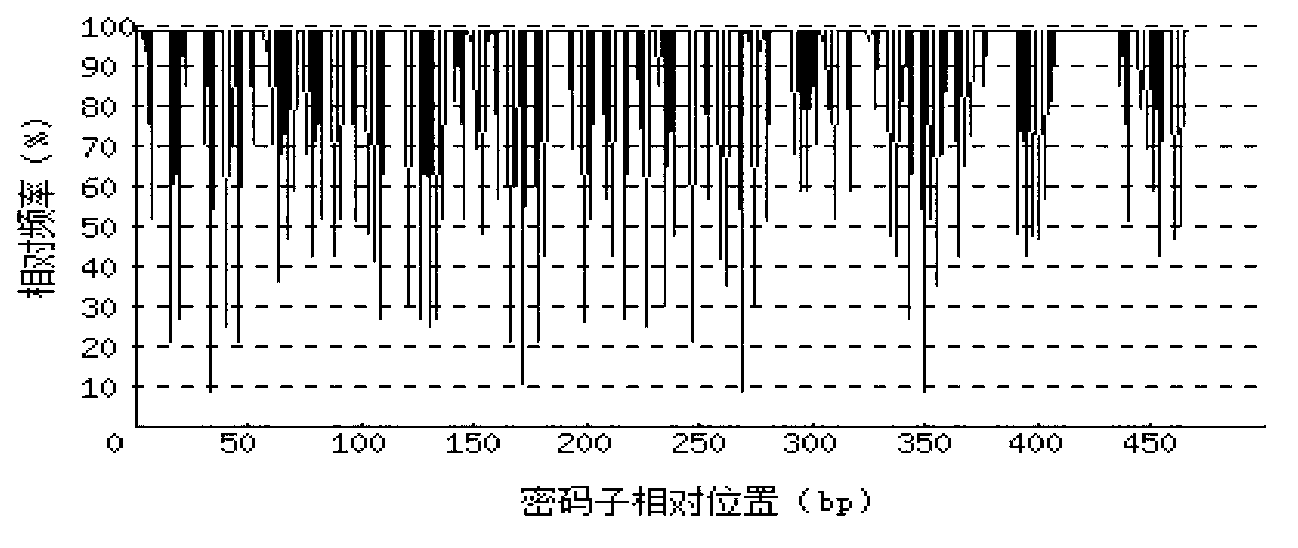Recombinant porcine interleukin 2, and encoding gene and expression method thereof
A technology of interleukin and expression method, applied in the field of recombinant porcine interleukin 2 and its coding gene, which can solve the problems of imperfect processing and modification system, host cell toxicity, non-physiological response, etc.
- Summary
- Abstract
- Description
- Claims
- Application Information
AI Technical Summary
Problems solved by technology
Method used
Image
Examples
Embodiment 1
[0065] Example 1 Recombinant porcine interleukin 2 gene optimization design
[0066] 1. Codon optimization
[0067] There are 64 genetic codes, but most organisms tend to use a subset of these. Those that are most frequently used are called optimal codons, and those that are not frequently used are called rare or low-usage codons. Virtually every organism commonly used for protein expression or production (including E. coli, yeast, mammalian cells, plant cells, and insect cells) exhibits some degree of difference or bias in codon usage. The expression efficiency of genes containing optimal codons in E. coli, yeast and Drosophila was significantly higher than that of genes containing low utilization codons. Therefore, in the heterologous expression system, the codon bias largely affects the expression of recombinant proteins. Gene synthesis using preferred codons and avoiding rare codons is called codon optimization. The optimization process fully takes into account vario...
Embodiment 2
[0090] Embodiment 2: Construction of the expression plasmid of recombinant porcine interleukin 2 gene
[0091] The fragment synthesized from the optimized recombinant porcine interleukin 2 gene (as shown in SEQ ID No: 1) was constructed into the pUC57 plasmid (provided by Nanjing GenScript Co., Ltd.) to obtain a long-term preservation plasmid, Denote as pUC57-prIL2 plasmid. Using the pUC57-prIL2 plasmid as a template, the upstream and downstream primers were respectively introduced into NdeI and XhoI restriction sites for PCR amplification. The sequences of the primers used are as follows:
[0092] Upstream primers:
[0093] P1: GGAATTCCATATGGCTCCGACCTCGTCGTCC
[0094] Downstream primers:
[0095] P2: GCCGCTCGAGTTACGTCAGGGTAGAGTAAATGC
[0096] The total volume of the reaction was 50 μL, in which 2.5 μL of each primer was added at a concentration of 10 μmol / L, and 1 μL of dNTP at a concentration of 10 mmol / L was added. The DNA polymerase used was Phusion High-Fidelity DNA...
Embodiment 3
[0098] Example 3 Expression and Identification of Recombinant Porcine Interleukin 2 in Escherichia coli
[0099] Specific steps are as follows:
[0100] 1. The pET21b-prIL2 plasmid with correct sequencing alignment in Example 2 was transformed into a competent strain of Escherichia coli BL21 (DE3) (purchased from Beijing Tiangen Biochemical Technology Co., Ltd.), and cultured overnight on an ampicillin plate at 37°C.
[0101] 2. On the second day, pick 1-4 recombinant colonies containing the pET21b-prIL2 plasmid, insert them into LB culture medium containing 100 μg / mL ampicillin, and culture them overnight at 37°C.
[0102] 3. Take 50 μL of the overnight culture and insert it into 5 mL of LB induction medium containing 100 μg / mL ampicillin, and culture at 37°C with shaking.
[0103] 4. The OD600 value of the bacterial solution was measured every 1 h after inoculation, and when the OD600=1.0, the expression was induced with 1 mmol / L IPTG (purchased from Amresco). At the...
PUM
 Login to View More
Login to View More Abstract
Description
Claims
Application Information
 Login to View More
Login to View More - R&D
- Intellectual Property
- Life Sciences
- Materials
- Tech Scout
- Unparalleled Data Quality
- Higher Quality Content
- 60% Fewer Hallucinations
Browse by: Latest US Patents, China's latest patents, Technical Efficacy Thesaurus, Application Domain, Technology Topic, Popular Technical Reports.
© 2025 PatSnap. All rights reserved.Legal|Privacy policy|Modern Slavery Act Transparency Statement|Sitemap|About US| Contact US: help@patsnap.com



